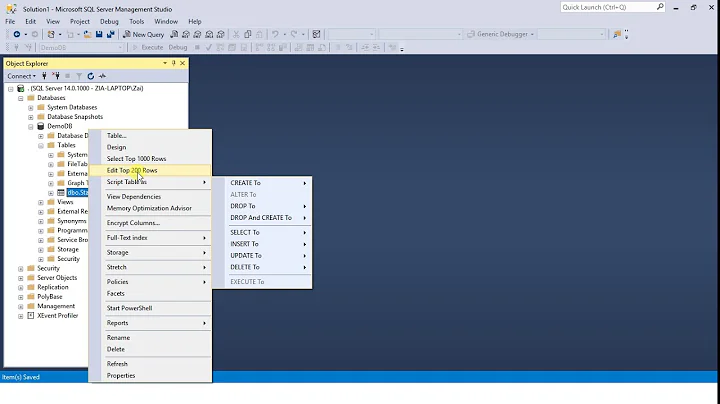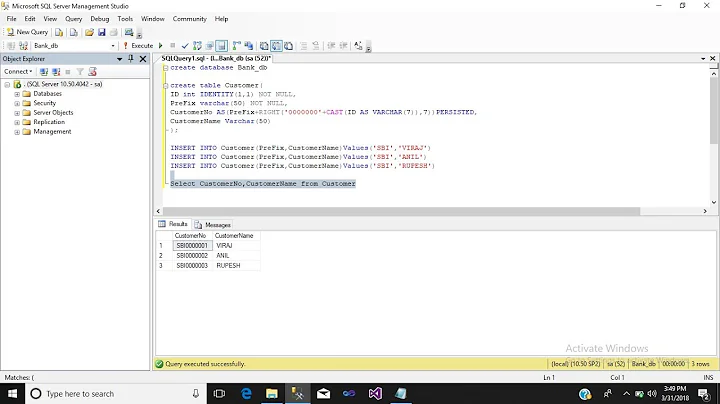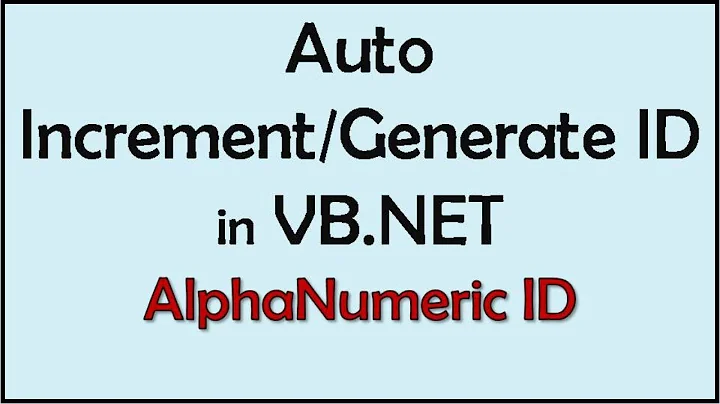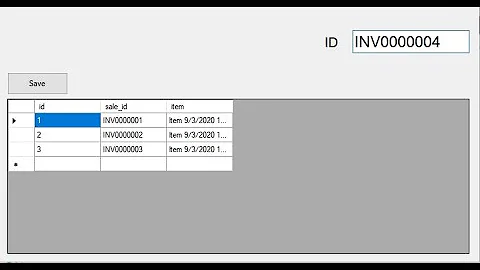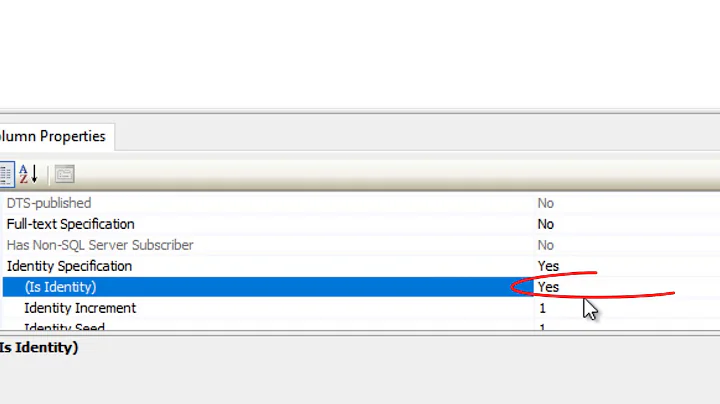Auto increment Alphanumeric ID in MSSQL
Solution 1
Try this one -
CREATE PROCEDURE dbo.NewEmployee
@EmployeeName VARCHAR(50)
AS BEGIN
SET NOCOUNT ON;
INSERT INTO dbo.tblEmployee(Employee_ID, Name)
SELECT
'EP' + RIGHT('0000' + CAST(Employee_ID + 1 AS VARCHAR(4)), 4)
, @EmployeeName
FROM (
SELECT TOP 1 Employee_ID = CAST(RIGHT(Employee_ID, 4) AS INT)
FROM dbo.tblEmployee
ORDER BY Employee_ID DESC
) t
END
Solution 2
I'm not suggesting over what you have currently but, i'd do this way. This is the way I've implemented in my application. Which im gonna give you. Hope you Like this. This is fully Dynamic and Works for all the Transaction you could have.
I've a table Which hold the Document Number as :
CREATE TABLE INV_DOC_FORMAT(
DOC_CODE VARCHAR(10),
DOC_NAME VARCHAR(100),
PREFIX VARCHAR(10),
SUFFIX VARCHAR(10),
[LENGTH] INT,
[CURRENT] INT
)
Which would hold the Data Like :
INSERT INTO INV_DOC_FORMAT(DOC_CODE,DOC_NAME,PREFIX,SUFFIX,[LENGTH],[CURRENT])
VALUES('01','INV_UNIT','U','',5,0)
INSERT INTO INV_DOC_FORMAT(DOC_CODE,DOC_NAME,PREFIX,SUFFIX,[LENGTH],[CURRENT])
VALUES('02','INV_UNIT_GROUP','UG','',5,0)
And, i'd have a fUNCTION OR Procedure but, i've an function here Which would generate the Document Number.
CREATE FUNCTION GET_DOC_FORMAT(@DOC_CODE VARCHAR(100))RETURNS VARCHAR(100)
AS
BEGIN
DECLARE @PRE VARCHAR(10)
DECLARE @SUF VARCHAR(10)
DECLARE @LENTH INT
DECLARE @CURRENT INT
DECLARE @FORMAT VARCHAR(100)
DECLARE @REPEAT VARCHAR(10)
IF NOT EXISTS(SELECT DOC_CODE FROM INV_DOC_FORMAT WHERE DOC_CODE=@DOC_CODE)
RETURN ''
SELECT @PRE= PREFIX FROM INV_DOC_FORMAT WHERE DOC_CODE=@DOC_CODE
SELECT @SUF= SUFFIX FROM INV_DOC_FORMAT WHERE DOC_CODE=@DOC_CODE
SELECT @LENTH= [LENGTH] FROM INV_DOC_FORMAT WHERE DOC_CODE=@DOC_CODE
SELECT @CURRENT= [CURRENT] FROM INV_DOC_FORMAT WHERE DOC_CODE=@DOC_CODE
SET @REPEAT=REPLICATE('0',(@LENTH-LEN(CONVERT(VARCHAR, @CURRENT))))
SET @FORMAT=@PRE + @REPEAT +CONVERT(VARCHAR, @CURRENT+1) + @SUF
RETURN @FORMAT
END
You can use the Function like :
INSERT INTO INV_UNIT(UNIT_CODE,UNIT_NAME,UNIT_ALIAS,APPROVED,APPROVED_USER_ID,APPROVED_DATE)
VALUES(DBO.GET_DOC_FORMAT('01'),@Unit_Name,@Unit_Alias,@APPROVED,@APPROVED_USER_ID,@APPROVED_DATE)
--After Transaction Successfully complete, You can
UPDATE INV_DOC_FORMAT SET [CURRENT]=[CURRENT]+1 WHERE DOC_CODE='01'
Or, you can create an Single Procedure which would handle all the things alone too.
Hope you got the way...
Hence, Looking at your Way, you are making an Mistake. You are getting SET @lastEmpID = ( SELECT TOP 1 Employee_ID FROM tblEmployee ORDER BY Employee_ID DESC )
Last employee id, and then you are manipulating the rest of the ID. This would create or reuse the ID that was generated earlier however deleted now. Suppose EMP0010 was there. After some day that EMP has been Deleted. So, When you again create an Employeee next time, You gonna have Same Emp ID you had before for anohter Employe but no more exits however. I dont think thats a good idea.
And, Instead of this :
DECLARE @NewEmployeeID as VARCHAR(6)
IF @numEmp < 10
SET @NewEmployee = SELECT 'EP000' + CONVERT(@EmpID)
IF @numEmp < 100
SET @NewEmployee = SELECT 'EP00' + CONVERT(@EmpID)
IF @numEmp < 1000
SET @NewEmployee = SELECT 'EP0' + CONVERT(@EmpID)
IF @numEmp >= 1000
SET @NewEmployee = SELECT 'EP' + CONVERT(@EmpID)
Which you used to repeat an Zero. You would use Replicate Function() of SQL. Like above on the Example of Mine.
SET @REPEAT=REPLICATE('0',(@LENTH-LEN(CONVERT(VARCHAR, @CURRENT))))
Solution 3
I don't think you need a Stored Procedure , Try using Ranking Functions
select
'EP'+RIGHT('000000'+ CAST(ROW_NUMBER() OVER (ORDER BY Name) AS VARCHAR(6)), 4)
AS [emp_code]
,
Name
FROM emp1 WITH(NOLOCK)
EDIT
select
'EP'+RIGHT('000000'+ CAST((ROW_NUMBER() OVER (ORDER BY Name)+10) AS VARCHAR(6)), 4)
AS [emp_code] --^Add the last Emp no.
,
Name
FROM emp1 WITH(NOLOCK)
Related videos on Youtube
nigel
Updated on September 15, 2022Comments
-
nigel over 1 year
I have an existing Stored procedure that generate employee ID. The employee ID have a format of EPXXXX, EP then 4 numeric values. I want my stored procedure to be shorten.

given the table (tblEmployee) above. Below is the stored procedure for inserting the new employee with the new employee number. The process is I have to get the last employee id, get the last 4 digits (which is the number), convert it to integer, add 1 to increment, check if the number is less than 10, 100 or 1000 or equal/greater than 1000, add the prefix before inserting the new records to the table.
create procedure NewEmployee @EmployeeName VARCHAR(50) AS BEGIN SET NOCOUNT ON DECLARE @lastEmpID as VARCHAR(6) SET @lastEmpID = ( SELECT TOP 1 Employee_ID FROM tblEmployee ORDER BY Employee_ID DESC ) DECLARE @empID as VARCHAR(4) SET @empID = ( SELECT RIGHT(@lastEmpID, 4) ) DECLARE @numEmpID as INT @numEmpID = ( SELECT CONVERT(INT, @empID) + 1 ) DECLARE @NewEmployeeID as VARCHAR(6) IF @numEmp < 10 SET @NewEmployee = SELECT 'EP000' + CONVERT(@EmpID) IF @numEmp < 100 SET @NewEmployee = SELECT 'EP00' + CONVERT(@EmpID) IF @numEmp < 1000 SET @NewEmployee = SELECT 'EP0' + CONVERT(@EmpID) IF @numEmp >= 1000 SET @NewEmployee = SELECT 'EP' + CONVERT(@EmpID) INSERT INTO tblEmployee(Employee_ID, Name) VALUES (@NewEmployeeID, @EmployeeName) END-
 Damien_The_Unbeliever almost 11 yearsIt would be far easier to store the numeric portion in a column by itself (possibly an
Damien_The_Unbeliever almost 11 yearsIt would be far easier to store the numeric portion in a column by itself (possibly anIDENTITYcolumn) and then have a computed column that produces this formatted value. In such a scenario, whether you also have a column to store the prefix or just hard code it toEPis a design decision.
-
-
nigel almost 11 yearsit's working, but what the process is there are existing records in the table and I need to put sequential ID for the employee and not by the name.
-
nigel almost 11 yearsThe table is already existing and i don't have the privilege to modify the structure. still thanks for the reply, this might be useful for future use.
-
Nirmal Subedi almost 11 yearsYou are creating an Whole Procedure That would produce an ID for an Just a SINGLE Transaction!!! Is this sounds good? Why don't you have an Procedure that would Generate an ID for All the Transactions that would have in your Application? If so then, now, You can suggest your Senior's there that way. Dont you! I think you have to. The way, you are doing, If you have 200 Types of Transactions like Employee, Like Agent, Supplier, Customer...What, Will you create Single Procedure foreach to generate an id? It would better you have an single procedure which could manage alllll. Suggest your Senior.
-
nigel almost 11 yearsIt's generating an error: "Conversion failed when converting the varchar value 'EP0004' to data type int."
-
 Prahalad Gaggar almost 11 yearsWhat do you mean by it's arranging the name and not the employee ids I am not getting you. If you can provide me the Complete data , than i can generate the full proof script.
Prahalad Gaggar almost 11 yearsWhat do you mean by it's arranging the name and not the employee ids I am not getting you. If you can provide me the Complete data , than i can generate the full proof script. -
nigel almost 11 yearsin my sample table the arrangement were EP0001 John, EP0002 Peter, EP0003 David, EP0004 George. Using the SQL Fiddle the output is. EMP011 David EMP012 Geroge EMP013 John EMP014 Peter
-
 Prahalad Gaggar almost 11 years@nigel Edited the answer.
Prahalad Gaggar almost 11 years@nigel Edited the answer.
